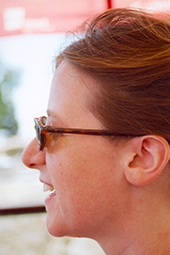| Julia Simner |
 Synaesthesia: the Aesthetic Consequences of Merging Senses Synaesthesia is an inherited condition linked to increased structural connectivity in the brain. Synaesthetes experience conscious, explicit cross-sensory sensations often described as a type of "merging of the senses" – for example, sounds may be seen in colour, smells may be felt as shapes. However, certain cross-sensory mappings are also felt intuitively by all people. For example, most people agree that high pitch sounds are more pleasing if paired with lighter (rather than darker) colours. It is likely that synaesthetes and non-synaesthetes experience cross-modality via qualitatively similar, but quantitatively different mechanisms. This talk will explore the aesthetic consequences of cross-sensory experience in both synaesthetes and non-synaesthetes, and show the impact of synaesthesia on aesthetic cognition and performance. I will show how synaesthesia has provided inspiration for artists, both in their subject matter and in their conception of art. I will also show how tests of creativity reveal synaesthetes to be exceptionally creative thinkers rather than creative performers (Catherine Mulvenna, "Synaesthesia and Creativity", in: J. Simner and E.M. Hubbard, The Oxford Handbook of Synaesthesia, Oxford University Press, Oxford (in press), but that this enhanced cognitive ability brings them to engage in the arts more often than non-synaesthetes. I will show how non-synaesthetes find aesthetic appeal in synaesthesia-like art and how the "rules" of synaesthesia (that is, the underlying system which pairs certain triggers with certain synaesthetic sensations) are based to some extent on hedonic (that is, pleasure-related) matching. Finally, I will discuss cases where synaesthesia provides negative aesthetic experiences and how this small corner of synaesthetic life has been overlooked by mainstream descriptions, which tend to focus on synaesthesia as an "aesthetic gift". Biography Dr. Julia Simner is a neuropsychologist, and editor of the Oxford Handbook of Synaesthesia. She studied languages at Oxford University, then specialised in Linguistics and Psychology, at the Universities of Toronto and Sussex. She began research in synaesthesia a decade ago after winning British Academy and Leverhulme research fellowships for that purpose. Her work focusses on the sensory and cognitive underpinnings of synaesthesia, and has been reported in over 100 media articles world-wide, including the NY Times, BBC, CBC, Telegraph, Times, New Scientist, Scientific American, etc. In 2010 she was recognised as an outstanding European scientist by the European Commission's Atomium Culture Initiative announced at the European Parliament in Brussels. In recognition, her science article "Yellow-tasting Sound" was published by Europe's leading newspapers (El Pais, Frankfurter Allgemeine Zeitung, Der Standard, Irish Times, etc.). She runs the Synaesthesia and Sensory Integration lab at the University of Edinburgh, Scotland. |

